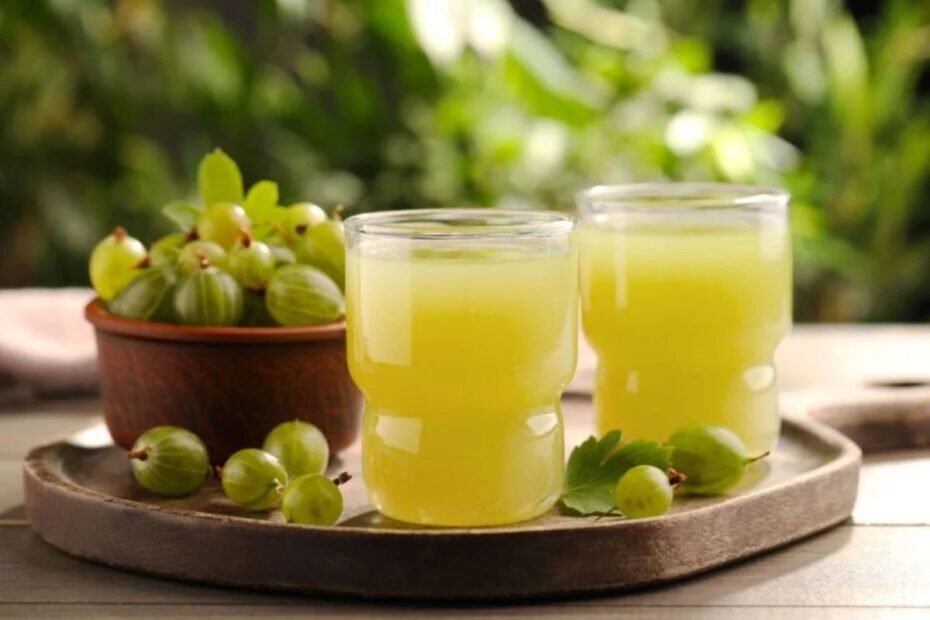Gooseberries are a familiar taste of summer, long cherished in home kitchens for making jams and preserves. Traditional folk remedies valued these small, juicy berries for their health benefits for generations. While people often use them for sweet spreads, gooseberry juice remains a lesser-known but worthwhile option. Despite their juiciness, extracting juice from gooseberries is a challenging task, and preserving it for winter requires some dedication. Still, if you’re wondering what to do with an abundant harvest, try making gooseberry juice—it’s delicious and packed with nutrients.
Gooseberries
The European gooseberry is a thorny, medium-sized shrub that grows naturally in many parts of the world. It is a member of the Grossulariaceae family and shares a close botanical relationship with currants. Over time, approximately 1,500 cultivated varieties have been developed. Depending on the type, gooseberries can be thornless and come in various colors—yellow, green, and deep red—where the sweetness depends on the berry’s skin color.
Gooseberry bushes typically bloom in May and June, with the fruit ripening by mid-summer. The best time to harvest is from late July to early August. Ripe gooseberries are sweet, full of juicy flesh, and dotted with small seeds, all enclosed in a tart-sweet skin, and that characteristic resembles grapes.
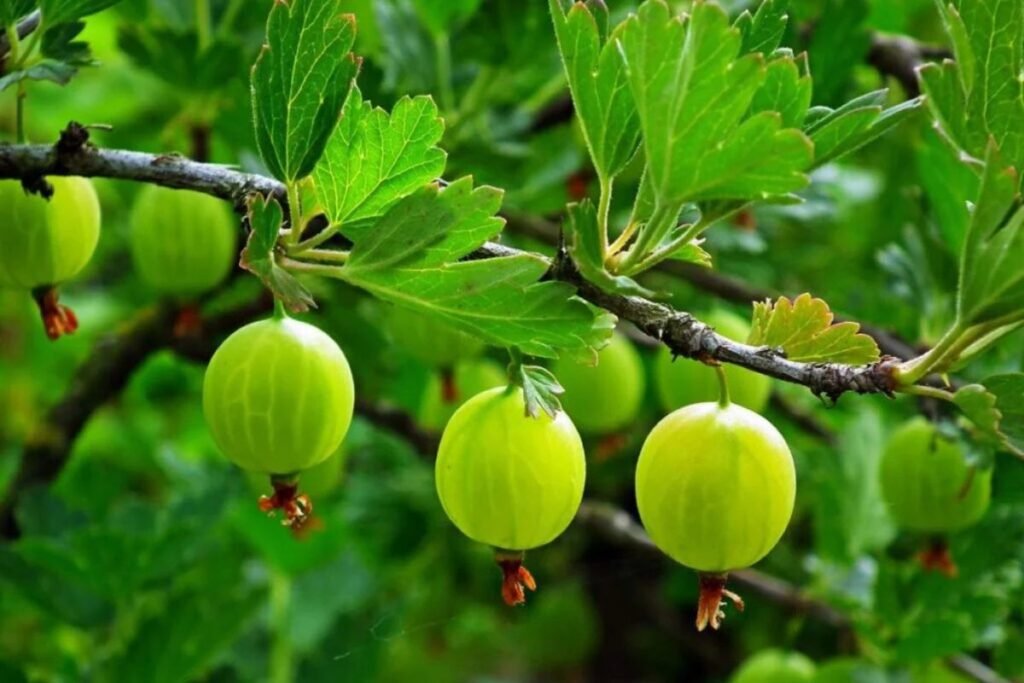
Nutrient-Dense Yet Low in Calories
Combining a low calorie count with a wealth of nutrients, gooseberries serve as an excellent snack that both satisfies and supports overall health. Children, anyone watching their weight, or those with nutritional deficiencies, particularly low iron levels, may enjoy every bite of gooseberry.
These berries are rich in vitamins A, C, and P, with various B-complex vitamins. They also contain key minerals such as iron, zinc, potassium, manganese, copper, and iodine. Antioxidants like anthocyanins and flavonoids further enhance their nutritional profile. In addition, gooseberries offer dietary fiber, tannins, and organic acids that support digestive and overall health.
Gooseberry Juice—A Healing Elixir
Although fresh gooseberries offer the most health benefits, their juice is a potent source of vital nutrients. Used in traditional remedies, gooseberry juice offers several therapeutic properties:
- Boosts metabolism, making it beneficial for people managing weight or following a structured diet.
- Acts as a natural laxative, helping relieve chronic constipation.
- Gooseberry juice supports liver and kidney function, encouraging the elimination of toxins from the body.
- It may lower blood pressure and strengthen blood vessel walls.
- This juice supports brain health, as its succinic acid content may help prevent spasms in cerebral blood vessels, even after processing.
- Offers anti-inflammatory and antioxidant effects, supporting overall immunity and cellular health.
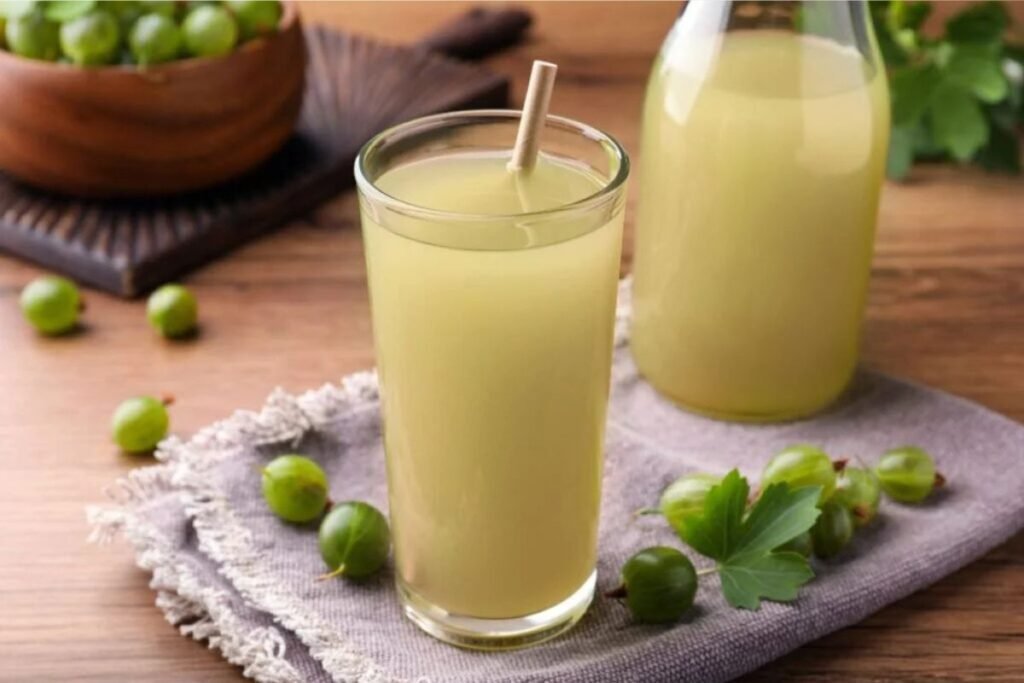
Gooseberry Juice—A Natural Ally Against Aging
Recent laboratory research has revealed that the natural phytonutrients found in gooseberries may help slow down aging. These berries contain specific antioxidant compounds that support skin elasticity, stimulate collagen production, and help reduce the appearance of wrinkles. Studies also suggest that these compounds can protect the skin from the harmful effects of UV radiation, so it is no surprise that gooseberry extract is a common ingredient in various skincare products.
Scientific studies further highlight the positive effects of gooseberries on hair health. The extract strengthens hair from the roots and may help prevent hair loss. Researchers have identified gooseberry extract as a potential treatment for alopecia (hair thinning and baldness).
Freshly Pressed Gooseberry Juice: A Healthy Challenge
It is possible to prepare fresh gooseberry juice for breakfast, but it’s far from simple. Thanks to their high pectin content, gooseberry juice tends to be thick and gelatinous, more like a smoothie than a drink. And squeezing out just one glass requires a generous number of berries.
Because of this thick texture, gooseberries work better as a flavorful ingredient in mixed fruit or berry smoothies. They lend natural sweetness, a pleasant tartness, and a velvety consistency. However, when using a blender, berry skins remain in the mixture. For a smoother drink, it’s a good idea to strain the juice before serving.
That said, one of the easiest and most beneficial ways to enjoy gooseberries is the simplest—eat them fresh. A small bowl of gooseberries as a mid-morning snack will give you a dose of vitamins and minerals without the extra effort of juicing.
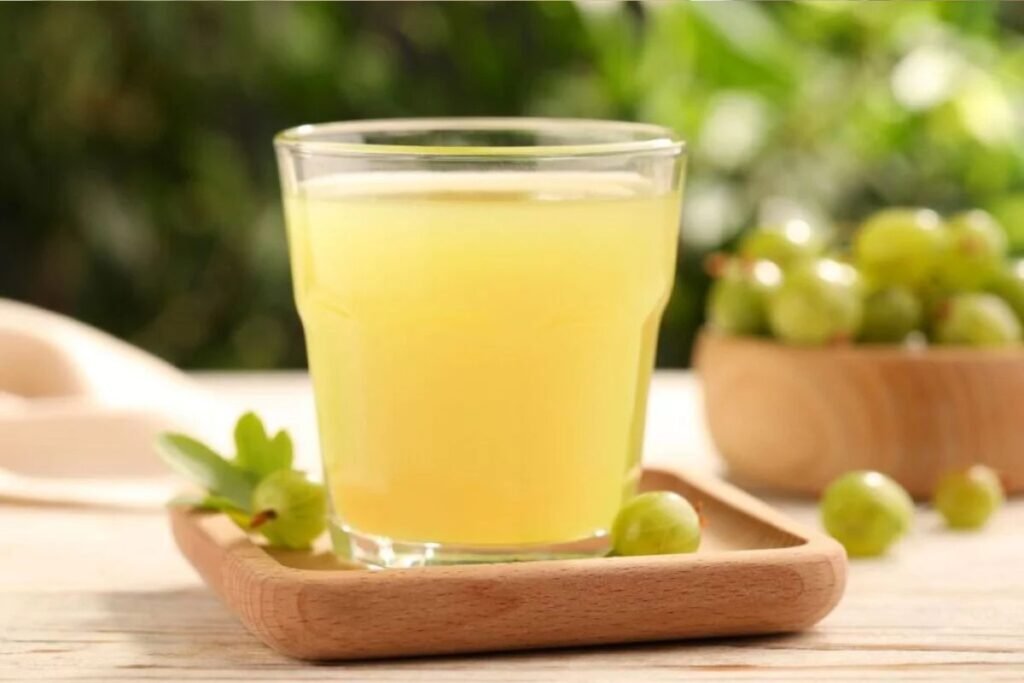
Pasteurized Gooseberry Juice with a Hint of Vanilla
Preserving gooseberry juice is a time-consuming process, and as mentioned earlier, eating the berries fresh is often the most practical choice. However, with their short growing season and typically abundant yield, making a batch of juice for winter can be a delicious way to use the harvest. Beyond jams, chutneys, and marmalades, pasteurized gooseberry juice with vanilla offers a unique and flavorful twist.
You’ll need:
- 3.5 kg (about 7.7 lbs) ripe gooseberries
- 300 g (about 1 ½ cups) sugar
- 1 liter (about 4 ¼ cups) of water
- 1 vanilla bean (optional)
Instructions:
- Remove the stems and blossom ends from the gooseberries, then rinse them thoroughly.
- In a large pot, combine water, sugar, and—if using—the vanilla bean.
- Bring the mixture to a boil, then add the cleaned gooseberries.
- Simmer over low heat for about 10 minutes.
- As the berries soften and burst, stir and gently mash them with a spoon.
- Place a piece of fine muslin or cheesecloth over the mouth of a large bowl or container.
- Pour the cooked berry mixture onto the cloth and let it strain naturally for about 12 hours until only dry pulp remains.
- Pour the strained juice into sterilized jars or bottles.
- Place the sealed jars in a wide pot filled with water up to the necks of the jars.
- Heat the water until it reaches 85°C (185°F), then turn it off. Let the jars sit in the hot water for another 20 minutes.
- Remove the jars, place them upside down on a towel, cover them with a thick cloth, and allow them to cool completely.
- Store the finished juice in a cool, dark place until ready to enjoy.
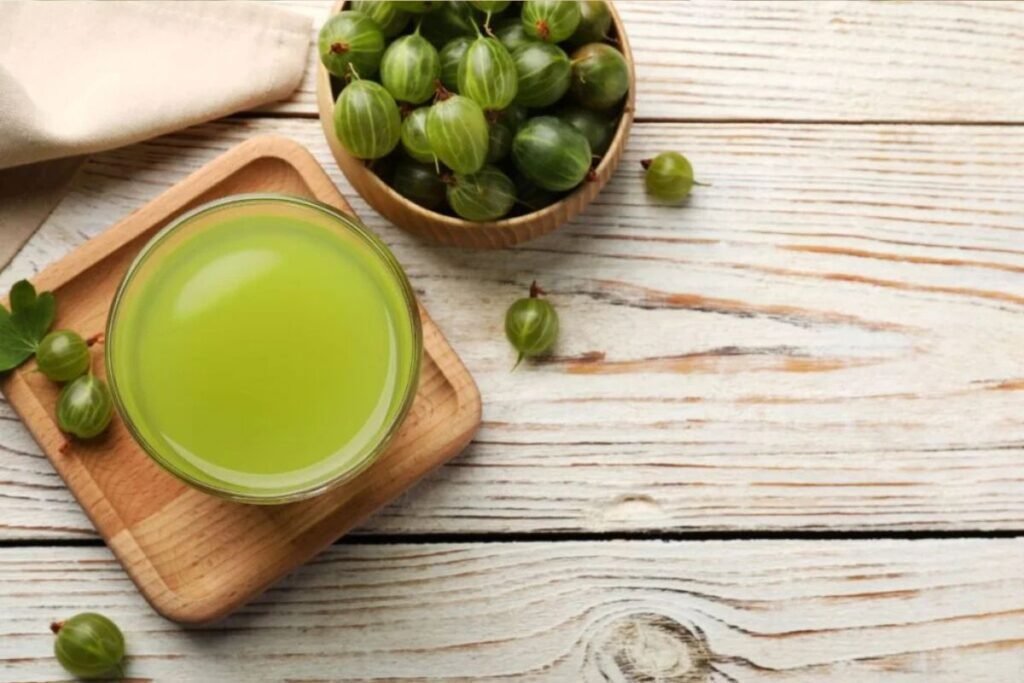
Making Gooseberry Juice at Home with a Juicer
As mentioned, gooseberries are surprisingly tricky to juice manually despite being juicy. Fortunately, a juicer can make the task far easier. If you have a suitable appliance at home, preparing your gooseberry juice for winter storage becomes more efficient.
Instructions:
- Begin by cleaning the gooseberries—remove stems and blossom ends, rinse them thoroughly, and pat them dry.
- Feed the prepared berries into your juicer and extract the juice.
- If the juice has an overly dense or pulpy texture, filtering it through a fine sieve or cheesecloth will help refine its consistency.
- Pour the juice into a large, non-reactive pot—enameled cookware is ideal.
- Add sugar (use approximately 150 grams, or ¾ cup, per liter of juice).
- Bring the juice to a gentle boil and simmer over low heat, stirring continuously until the sugar dissolves.
- While still hot, pour the juice into sterilized, heat-resistant jars or bottles and seal them tightly.
- Wrap the sealed jars in a clean towel, and cool completely evenly at room temperature.
- Store the juice in a cool, dark place for optimal preservation.
A Glimpse into Culinary History: Traditional Gooseberry Juice Recipe
Some cultures’ cookbooks published a gooseberry juice recipe at the end of the 19th century. The book author suggests this preparation, spanning ten days, which calls for sunlight and raw egg white—a technique that might sound unusual or exotic today. Yet, it represents an authentic piece of culinary heritage. Are you curious to try this vintage recipe in a modern kitchen? Here you go:
- This traditional method uses unripe gooseberries, typically harvested before Midsummer Day (St. John’s Day).
- The berries are thoroughly mashed in small batches and transferred into a large container.
- After that, extract the pulp through a fine muslin bag or tightly woven fabric to extract the liquid. You will need considerable pressure—wooden boards or a press can help extract every drop.
- The strained juice is poured into a glass or ceramic vessel, covered with breathable fabric (like cheesecloth or linen), and left to ferment gently in direct sunlight for 6 days.
- After this period, skim off the foam that forms on top, and add one raw egg white to the juice.
- The vessel is covered again and left to sit for another 4 days.
- After the total 10-day process, again strain the juice carefully and pour it into sterilized bottles or jars. Add a slice of lemon to each container before sealing.
- Store the finished juice in a cold place.
Note: According to historical annotations, housewives commonly used this juice to prepare fruit tea or thicken desserts like kissel (a traditional fruit jelly drink).
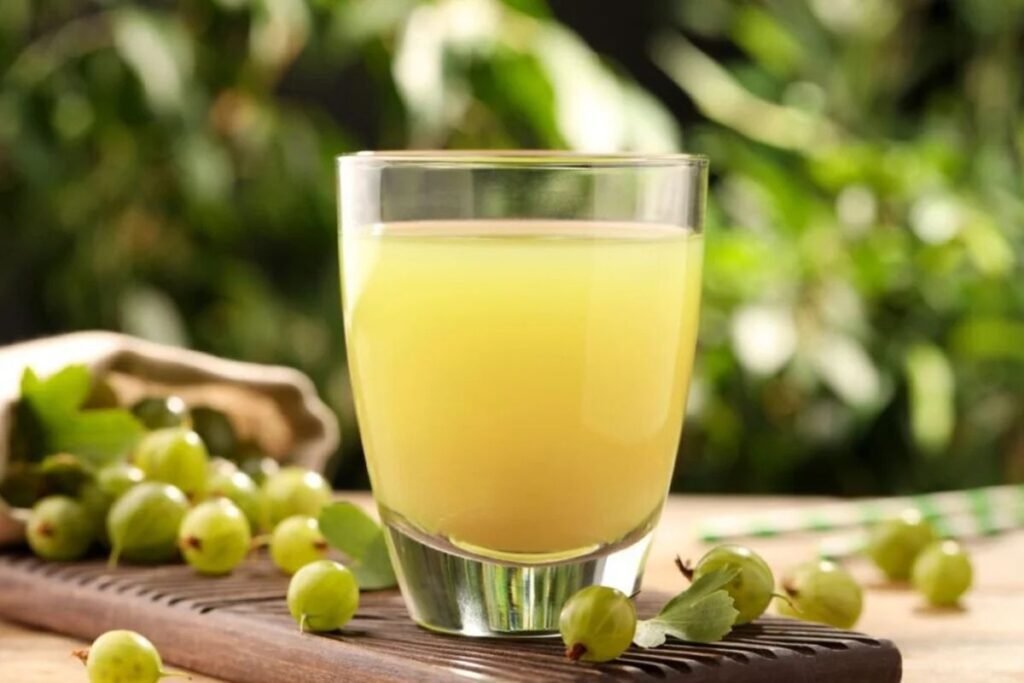
Gooseberry Juice: A Healthful Choice for (Almost) Everyone
For most people, gooseberry juice is safe and healthy, as long as it’s consumed in moderation. It is packed with vitamins and antioxidants, making it a valuable addition to a balanced diet. However, excessive or frequent consumption may lead to digestive discomfort—such as stomach cramps, diarrhea, or nausea—especially in sensitive individuals.
For those with certain health conditions, such as diabetes, peptic ulcers, or inflammatory bowel diseases, gooseberry juice may not be advisable. It’s best to ask healthcare professionals for advice in such cases before incorporating it into your routine.
Sources:
- https://www.medicalnewstoday.com/articles/gooseberry-benefits
- https://www.healthline.com/nutrition/indian-gooseberry
Associative photos © Canva
